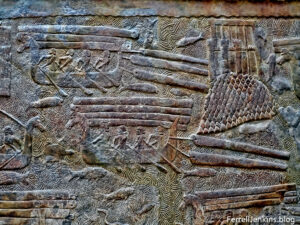Data analysis is very important in the translation and research of the source text of the Hebrew Bible. With data analysis, translation choices can be better supported if you know how to use the tools available. Understanding the syntactical structures of the source texts is indispensable for good interpretation and translation. Most of the time, these structures are determinative for which translations are possible, and which are not because they don’t do justice to the Hebrew. SHEBANQ is a tool with which that is possible, but it can take some time to get used to.
The past few weeks I have been doing an internship at the ETCBC. The goal of my internship was to make the BHSA database more accessible for non-programmers. So that, for example, Bible translators can learn how to write queries in SHEBANQ in a way that is not too time-consuming and that can be very useful. The result of my internship is a tutorial for beginners that guides you through the process of writing queries in the query language MQL, to analyze syntactical patterns in the Hebrew Bible. The tutorial also provides useful information and links on how to use the SHEBANQ text to its full extent.

Did Cain receive a sign, or was he made a sign (Genesis 4,15)? One of the questions addressed in the tutorial (Ivory, from the Cathedral of Salerno ca. 1384) Louvre, Paris
Of course, in order to explain SHEBANQ to others, I first had to learn how to use SHEBANQ myself. I have used the experience of learning MQL within SHEBANQ to write the tutorial on how to get started with querying in SHEBANQ. The tutorial contains many examples with descriptions to get familiar with writing queries and to see if SHEBANQ can be useful for you. The examples can even serve as templates if you want to execute similar searches.
In Bible translation, many different disciplines are involved. One of these disciplines is the linguistic analysis of the source texts with tools like SHEBANQ. Of course, this will never be the sole solution to all translation problems, but it certainly has to be taken into consideration what tools like this can mean for the practice of translation. When you want to translate properly, you cannot disregard syntactical analysis and comparison of the source text.
With SHEBANQ, the linguistic information from the morpheme level up to the discourse level of the BHSA database is easily available. With this information, you can check how a certain verse is coded and use that information to write a query to find similar situations. You can, for example, search for every occasion where the same subject (e.g. Abimelech) starts speaking to the same complement (e.g. Abraham) multiple times in a row without the complement answering in between (e.g. in Genesis 20,9-10). You can also write a query to search for a particular word in a specific grammatical situation, for example, נתן + double object (‘to make into’). Another option is to search for corresponding grammatical constructions, to check if a certain translation of that construction is also possible in other cases. For example, to examine for Deut. 29,3[4] whether it is possible to translate the verse as if it contains a turning point (c.f. example 6 in the tutorial).

Were Solomon’s cedars put on rafts? Another question addressed in the tutorial. — Sargon transporting cedar logs from Lebanon by sea. Displayed in the Louvre. Photo by Ferrell Jenkins
The tutorial contains 10 examples that show how SHEBANQ can be used for translational and exegetical purposes. These examples can help you in determining if SHEBANQ can be useful for you if you are still doubting about learning how to use it. These examples can also be instructive and help you to get a concise overview of what is possible with SHEBANQ. After the examples, detailed information on how to start querying with MQL in SHEBANQ follows. There are also a few appendixes that can be used as a quick reference guide, if, for example, you want to know what a certain operator does.
Now, because of the tutorial, the database is more accessible for translators, students, and researchers who want to use the BHSA database for syntactical or morphological analysis. You can download the tutorial and start querying today.
Link to the tutorial: https://github.com/ETCBC/Tutorials/blob/master/SHEBANQ%20tutorial%202021.pdf


